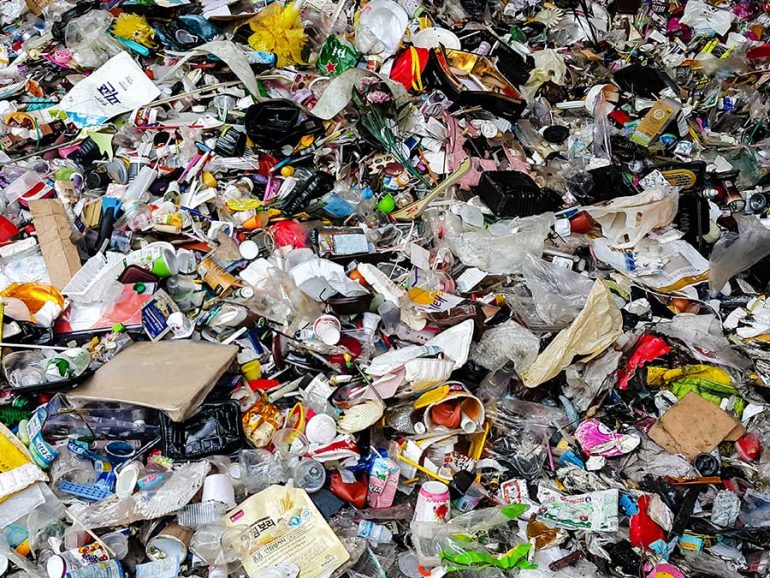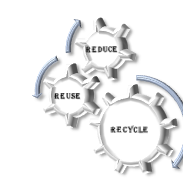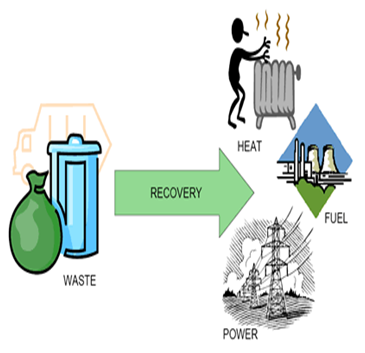
The waste should be treated as RESOURCE and to recycle non-biodegradable recyclable component from the waste thereby providing Energy to Power generation or product generation plants.
STATISTICAL VIEW
- 377 million people residing in urban area generate 62 million tons of MSW per annum currently and it is projected that by 2031 these urban centers will generate 165 million tons of waste annually and by 2050 it could reach 436 million tons. To accommodate this amount of waste generated by 2031, about 23.5 × 107 cubic meters of landfill space is required and in terms of area, it would be 1,175 hectares of land per year. The area required from 2031 to 2050 would be 43,000 hectares for landfills piled in 20-meter height. These projections are based on 0.45 kg/capita/day waste generation.
- On an average only 70% waste collection is observed, while the remaining 30% is again mixed up and lost in the urban environment. Out of total waste collected, only 12.45% waste is scientifically processed and rest is disposed of in open dumps.
DIFFERENT TYPES OF INDIAN MUNICIPAL SOLID WASTE
 Biodegradable Waste: Food and kitchen waste, green waste (vegetables, flowers, leaves, fruits) and paper.
Biodegradable Waste: Food and kitchen waste, green waste (vegetables, flowers, leaves, fruits) and paper. Recyclable Material: Paper, glass, bottles, cans, metals, certain plastics, etc.
Recyclable Material: Paper, glass, bottles, cans, metals, certain plastics, etc. Inert Waste Matter: C&D, dirt, debris.
Inert Waste Matter: C&D, dirt, debris. Composite waste: Waste clothing, Tetra packs, waste plastics such as toys.
Composite waste: Waste clothing, Tetra packs, waste plastics such as toys. Domestic Hazardous Waste (also called “household hazardous waste”) and toxic waste medicine, e-waste, paints, chemicals, light bulbs, fluorescent tubes, spray cans, fertilizer and pesticide containers, batteries, and shoe polish.
Domestic Hazardous Waste (also called “household hazardous waste”) and toxic waste medicine, e-waste, paints, chemicals, light bulbs, fluorescent tubes, spray cans, fertilizer and pesticide containers, batteries, and shoe polish.
SOLID WASTE MANAGEMENT PRACTICES AND CHALLENGES IN INDIA
 Segregation: This is the major challenge now as no particular methodology is not implemented to segregate the waste.
Segregation: This is the major challenge now as no particular methodology is not implemented to segregate the waste. Collection: If segregation fails to separate at initial stage collection also takes worst part.
Collection: If segregation fails to separate at initial stage collection also takes worst part. Reuse/recycle: This entails activities like collecting those materials from the waste, which could be gainfully retrieved and utilized for making new
Reuse/recycle: This entails activities like collecting those materials from the waste, which could be gainfully retrieved and utilized for making new Disposal: The possible reason for reduction could be that the waste generated could not reach the designated dumping site and was lost in the cities peripherals, outskirts, along the road, low lying area, along the drain, green areas, etc. Data reveal that uncontrolled open dumping is a common feature in almost all cities. The following disposal practices are in use in hierarchy.
Disposal: The possible reason for reduction could be that the waste generated could not reach the designated dumping site and was lost in the cities peripherals, outskirts, along the road, low lying area, along the drain, green areas, etc. Data reveal that uncontrolled open dumping is a common feature in almost all cities. The following disposal practices are in use in hierarchy. Open dumping
Open dumping Landfilling
Landfilling
CHALLENGES
 Awareness to enhance segregation
Awareness to enhance segregation Characterization of municipal solid waste
Characterization of municipal solid waste Urbanization and lack of appropriate level funding
Urbanization and lack of appropriate level funding Implementation of rules at ground level
Implementation of rules at ground level Financial auditing and work study
Financial auditing and work study Resistance for notification of new landfill site
Resistance for notification of new landfill site Lack of coordination among Centre and State
Lack of coordination among Centre and State Appropriate technological solution, Outsourcing and PPP
Appropriate technological solution, Outsourcing and PPP Failure of waste-to-energy projects
Failure of waste-to-energy projects Involvement of organized sector
Involvement of organized sector
PH1 HIERARCHIC APPROACH
 REDUCE: WASTE AS MUCH AS
REDUCE: WASTE AS MUCH AS REUSE: PRODUCTS AS MANY TIMES AS POSSIBLE
REUSE: PRODUCTS AS MANY TIMES AS POSSIBLE RECYCLE: RESOURCES TO THE GREATEST POSSIBLE EXTENT
RECYCLE: RESOURCES TO THE GREATEST POSSIBLE EXTENT
PH1 IMPLEMENTATION
WHAT : What we do
 Source separation, e.g. packaging, paper, glass, WEEE
Source separation, e.g. packaging, paper, glass, WEEE Generation of secondary raw materials, e.g. glass, paper, plastics, scrap, metals, bio-materials, textiles
Generation of secondary raw materials, e.g. glass, paper, plastics, scrap, metals, bio-materials, textiles Energy recovery of remaining residual waste
Energy recovery of remaining residual waste Production of refuse derived fuels (RDF) and secondary recovered fuel (SRF)
Production of refuse derived fuels (RDF) and secondary recovered fuel (SRF)
WHY:Why you have to choose us
-
 Optimised Energy Utilisation by Cogeneration
Optimised Energy Utilisation by Cogeneration Energy Recovery
Energy Recovery Simple & rigid construction (flexible)
Simple & rigid construction (flexible) Low space requirement
Low space requirement 100% environmental friendly
100% environmental friendly Low operation & maintenance costs
Low operation & maintenance costs Approved and patented products
Approved and patented products
HOW :How we will implement the system
 Shredder, Magnetic Separator, Disc Separator
Shredder, Magnetic Separator, Disc Separator 2/3 Dryers (coarse/fine fraction) Emission Control for Dryers Drum Separator Hand sorting station Bailing press for recyclables Conveyers
2/3 Dryers (coarse/fine fraction) Emission Control for Dryers Drum Separator Hand sorting station Bailing press for recyclables Conveyers Incinerator/gasifying System (incl feeder/deashing) Steam Boiler Steam engine / turbine Hot air exchanger
Incinerator/gasifying System (incl feeder/deashing) Steam Boiler Steam engine / turbine Hot air exchanger Direct injection Emission Control Absorber Emission control Fan & stack Automated control system
Direct injection Emission Control Absorber Emission control Fan & stack Automated control system


